Guide to electric vehicle (EV) charging
Guide to electric vehicle (EV) charging
Introduction
As more people switch from petrol and diesel cars to electric, the demand for electric vehicle charging is rising. This buying guide tells you everything you need to know about electric vehicle charging. It explains what the different types of EV charging stations and charging cables are. It covers EV home charger installation and how public EV charging stations work. And it highlights some things to consider when charging an electric vehicle.
How to Charge an Electric Vehicle
All electric vehicles have a rechargeable battery that powers an electric motor. The battery is charged by plugging it into the mains electricity. All that’s needed to do this is a charge point or plug socket, and a compatible cable running from the charge point to the vehicle.
There are three places you can charge an electric car: at home, at work, or at a public charging point.
Electric car charging at home offers the greatest benefits. For example, the electricity used costs less than other charging points and it’s more convenient because the vehicle can be plugged in overnight and have a recharged battery the following day. EV home chargers are also waterproof and have built-in safety features such as full electrical protection, including over/under temperature.
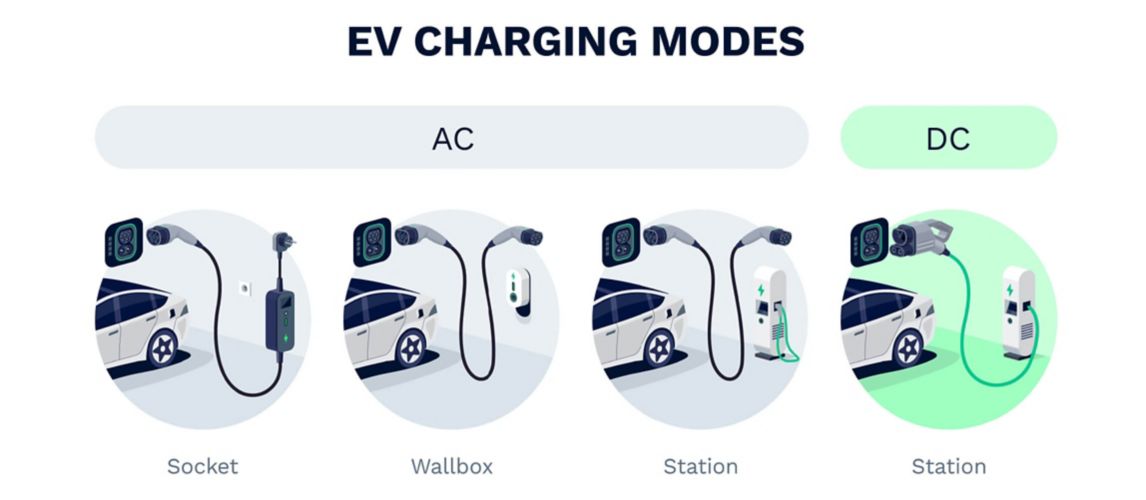
Types of EV Charger
There are three main types of EV chargers: rapid, fast and slow. Each type charges at different speeds, determined by their power outputs (measured in kilowatts (kW)) and how they convert AC power (the type supplied in the UK) into DC power (the kind used by batteries).
Generally, AC electricity is used for slow and fast charging. The vehicle’s onboard charger converts the AC power to DC to be sent to the battery. DC charging is used for rapid charging, and in this case, the conversion from AC to DC occurs in the charging point. There are some exceptions to this rule, though.
In the following sections we take a more detailed look at each type of EV charger. We look at the connector types they use, where they’re found and their average charging times.
Charge times vary depending on the vehicle’s battery size. The times quoted below are based on an average electric car’s battery being charged to 80% (charging slows down after this point to protect the battery). Charge time can also be increased by cold temperatures and extreme heat.
Rapid Chargers Explained
Rapid chargers supply high power to charge a vehicle as fast as possible. They all have tethered cables, which means the cable is attached to the charger.
There are three levels of rapid chargers:
-
100+ kW DC chargers provide ultra-rapid charging in 20-25 minutes. They use a CHAdeMO or CSS connector.
-
50kW DC chargers charge in 20-60 minutes. They use a CHAdeMO or CSS connector.
-
43kW AC chargers charge in 20-40 minutes. They use a type 2 connector.
It’s also worth noting that Tesla EV vehicles have their own network of superchargers, the majority of which only they can use, but some have been opened for other electric vehicles to use.
Rapid charging can only be used on vehicles with rapid-charging capabilities. And some vehicles with rapid charging can only accept a maximum of 50kW DC. However, they can still use 100+kW charge points as the vehicle will automatically restrict the power to what it can take.
Rapid chargers are only found at public charge points, and they can’t be installed in homes.
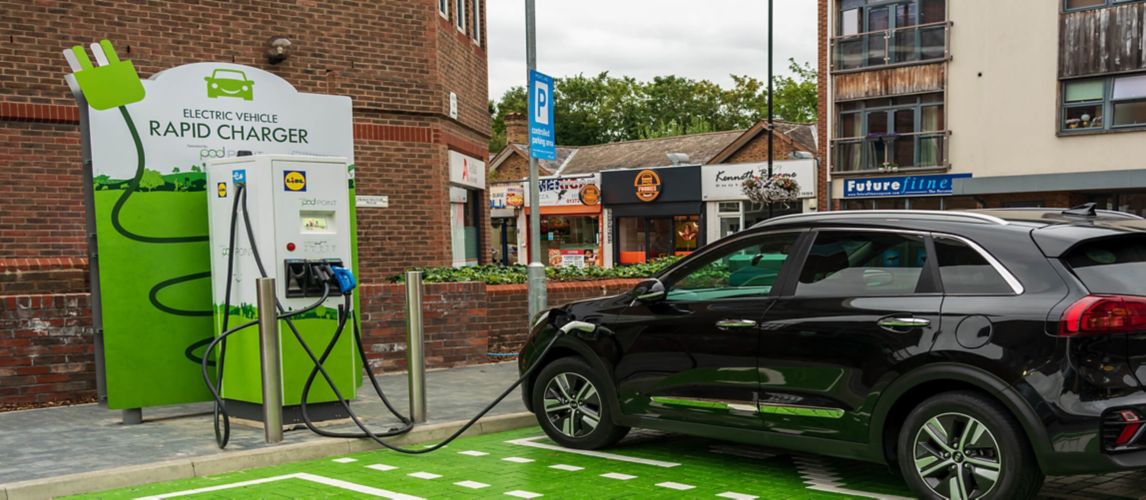
Fast Chargers Explained
Fast chargers usually have a 7kW or 22kW power output and can have tethered or untethered cables.
-
22kW AC chargers charge in 1-2 hours. They use a type 1 or type 2 connector.
-
7kW AC chargers charge in 4-6 hours. They use a type 1, type 2 or commando connector.
Most public charge points with fast chargers provide AC charging as above. But there are some networks now using DC chargers that use a CHAdeMO or CSS connector.
Some electric vehicles can only accept a maximum of 7kW AC. However, they can still use 22kW charge points as the vehicle will automatically restrict the power to what it can take.
7kW fast chargers are available at public charge points, and they can also be installed in homes. However, 22kW chargers require three-phase power (where power flows through three conductors), which is very rare in UK homes. So, most 22kW fast chargers are found at workplaces that have large commercial buildings.
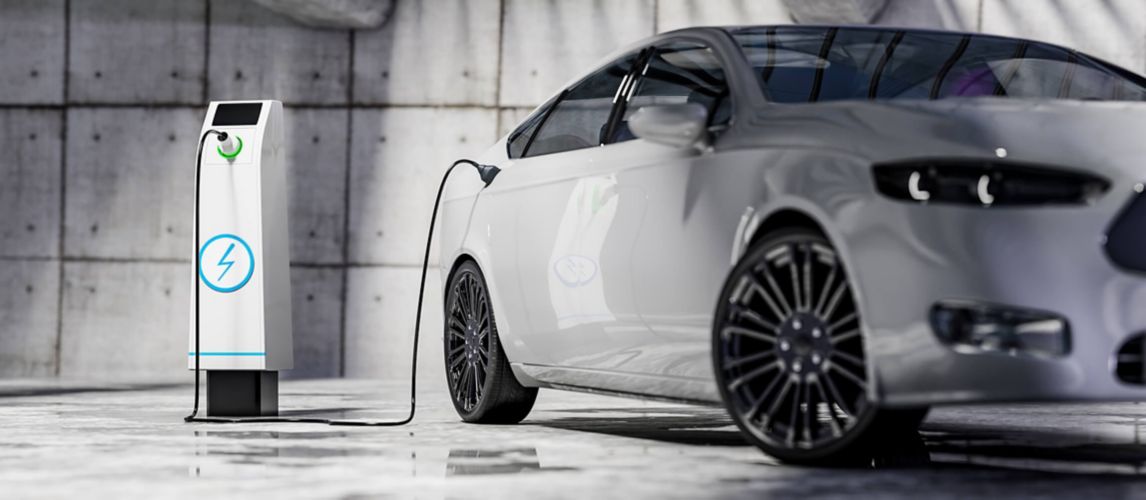

Types of EV Charging Plug
Electric vehicles are plugged into EV charging points with a cable. The cable has a charging plug or connector on each end, which fits into the charging point and the vehicle’s inlet port. Your choice of EV charging cables with connectors will depend on the charger type and the vehicle's inlet port. There are six connector types available:
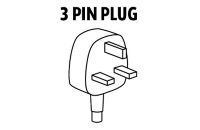
3-pin : A 3-pin charging plug plugs into a standard 3-pin plug socket in a home rather than an EV charging point. It’s a single-phase charger because power flows through a single conductor.This type of charging is very slow. The maximum current a domestic socket can draw is 2.3kW, so charging with a 3-pin plug will provide around 8 miles for every hour the battery is on charge. Therefore, it’s only recommended for occasional or emergency use at home. The connector on the other end of the cable that plugs into the car must be compatible with the connection type on the vehicle

Type 1 EV charger : A type 1 EV charger is an AC charger with a 5-pin plug. It can only plug into a compatible electric vehicle’s inlet port – it’s never used as the part that plugs into the charger. It’s a single-phase charger because power flows through a single conductor. Type 1 EV charger plugs work with two types of chargers: slow chargers with a power rating of 2.3-6kW, providing approximately 12.5 miles for every hour of charge. And fast chargers with a power rating of 7kW, providing about 25 miles for every hour of charge.Type 1 EV chargers are typically used for electric charging at home and at public charge points.

Type 2 EV charger : A type 2 EV charger is a 7-pin plug - the most commonly used charger plug found on electric vehicles and charge points. There are single-phase chargers, where power flows through a single conductor, and three-phase chargers, where power flows through three conductors. Type 2 EV chargers can work with several power outputs.
- AC single-phase slow chargers with a power rating of 3.7kW, providing approximately 12.5 miles for every hour of charge.
- AC single-phase fast chargers with a power rating of 7kW, providing approximately 25 miles for every hour of charge.
- AC three-phase fast chargers with a power rating of 22kW, providing approximately 75 miles for every hour of charge.
- DC rapid chargers with a power rating of 150kW, providing 225 miles for every hour of charge (only compatible with Tesla vehicles).
- DC rapid chargers with a power rating of 250kW, providing 375 miles for every hour of charge (only compatible with Tesla vehicles). The first two options are used for electric car charging at home, in the workplace or at public charge points. The other options are only used at public charge points.

Commando: A commando charger is a simple plug-and-play charger used for electric car charging at home. It consists of a commando socket and a commando cable that connects to the electric vehicle. It’s an AC, single-phase charger that can deliver up to 7kW of power, providing approximately 25 miles for every hour of charge

CHAdeMO plug : A CHAdeMO plug is a DC charger with a 4-pin plug that fits into a compatible electric vehicle’s inlet port. The other end of the cable is tethered to the charging port. It’s a single-phase charger because power flows through a single conductor. CHAdeMO plugs are used for rapid charging found at public charge points with two power ratings:
- A power rating of 50kW, providing approximately 75 miles for every hour of charge.
- A power rating of 150kW, providing approximately 150 miles for every hour of charge.

Combined Charging System (CCS) plug: A combined charging system plug is a DC charger with a 5-pin plug that fits into a compatible electric vehicle’s inlet port. The other end of the cable is tethered to the charging port. It’s a single-phase charger because power flows through a single conductor. CCS plugs are used for rapid charging found at public charge points with three power ratings:
- A power rating of 50kW, providing approximately 75 miles for every hour of charge.
- A power rating of 150kW, providing approximately 225 miles for every hour of charge.
- A power rating of 350kW, providing approximately 525 miles for every hour of charge.
EV Home Charger Installation
The cheapest and most convenient way for EV owners to recharge their vehicle is by having an EV charge point at home.
Slow and fast charge points with a power output of between 7kW and 22kW are suitable. However, this will depend on the home's current wiring as 22kW chargers require three-phase power (where power flows through three conductors), which is rare in UK homes.
EV home charger installation is a complex job involving setting up a dedicated electrical circuit running from the home's consumer unit to the EV charge point. So, it must be carried out by an electrician qualified in EV home charger installation.
When an EV charge point is installed into a home, it must be registered with the Distribution Network Operator (DNO). This is the company responsible for bringing electricity to the house. Usually, the installer will register the device, but it’s always best to check.
Tethered or untethered charging system
The difference between a tethered and untethered charge point is simple. A tethered charge point has a cable permanently attached to the charger, while an untethered charge point doesn’t.
Tethered cables are attached to the charge point and have a type 1 or type 2 EV charger. They offer convenience because there's no need to get the cable out of the car or garage every time the car needs charging. However, the cable needs to be tidied away after use. And there's also a risk that the charger will need changing if the owner swaps their vehicle to one that requires a different connector. Or it could become obsolete if the industry moves away from type 1 and type 2 electric car chargers.
An untethered charger gives more flexibility should the homeowner buy an EV vehicle with a different plug requirement in the future. Most EV vehicles come with a cable included, but the owner will need to purchase one if it’s not or if they ever need a replacement.
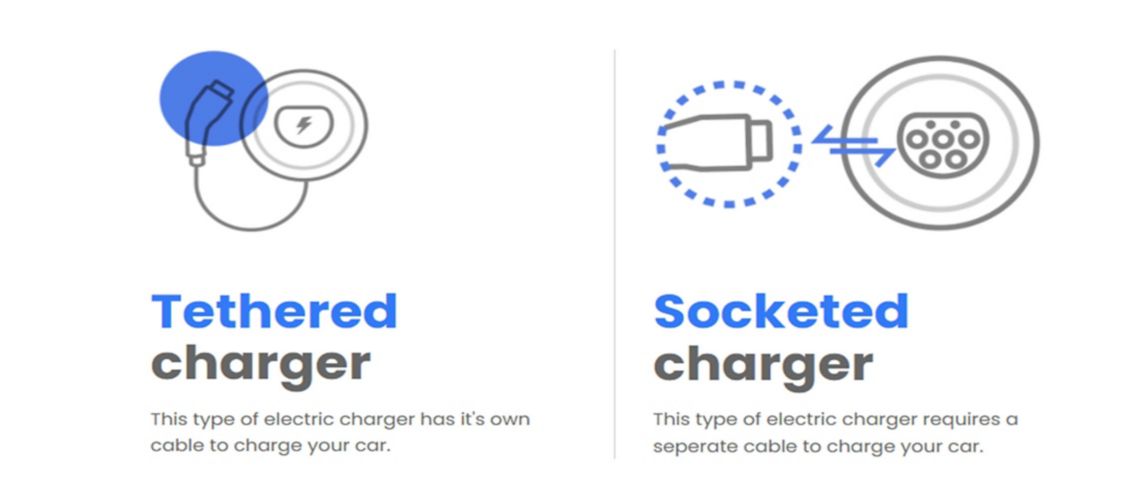
How much to install an electric car charging point?
Electric vehicle home charger prices can vary significantly, ranging from a few hundred pounds to a couple thousand pounds. You then need to factor in the installation cost, which must always be carried out by an approved company or qualified electrician.
A government Electric Vehicle Homecharge Scheme is currently available that can help with up to 75% of the costs (capped at £350). However, this is now only open to homeowners living in flats and people living in any type of rented accommodation.
At the time of writing, there is also a government scheme for businesses called the Workplace Charging Scheme (WCS). It's a voucher-based scheme that contributes towards the cost of purchasing and installing electric vehicle charge points. Companies can claim up to £300 per charge point for up to 20 sockets.
Where to put a home charge point
There are a few things to consider when deciding where to put a home charge point:
-
Does it need to be hidden from view?
This is really a matter of preference, but it makes a difference to whether a tethered or untethered charge point is installed. An untethered charge point looks tidy because the cable can be detached and put somewhere else. But a tethered cable will have the cable coiled around it, which may look unsightly at the front of a house. -
Can the cable comfortably reach the car from the desired charge point position without causing a trip hazard?
This will depend on where the socket on the vehicle is. Some sockets are on the front or back, but some are on the side. Longer EV charging cables can be purchased if necessary, but an untethered charge point will need to be installed to use a separate cable. [Text Wrapping Break] -
Can the charger pick up the home’s WiFi signal from the desired charge point position?
EV chargers need access to the home's WiFi signal to take advantage of smart features, such as off-peak energy tariff and remote charging. So, ensure the charger is installed in a position where the signal can reach it. -
How far is the desired charge point position from the home’s consumer unit?
A standard installation uses 15m of cable. If the distance between the charge point and consumer unit is more than that, groundworks may be needed, which will increase the cost of installation.
How Often do You Have to Charge an Electric Car?
The frequency with which an electric car needs to be charged varies depending on two things:
The size of the car’s battery: a vehicle with a battery capacity of around 100kW won't need charging as often as a vehicle with a battery capacity of about 30kW, providing they’re doing the same mileage.[Text Wrapping Break]
The number of miles travelled: a car that travels 50 miles a day needs to be charged more often than a car that travels 10 miles a day, assuming they have the same size battery.
EV batteries should only be charged to 80% capacity for efficiency because the heat from constant charging can degrade the battery over its lifetime.
How do Public EV Charging Stations Work?
Public EV charge points can be found all over the country, in car parks, supermarkets, service stations, and even at the side of roads on lampposts. Not every charge point will be compatible with every car, and costs and charge speeds will vary.
Every public EV charge point belongs to a particular network. They can have different approaches to how their chargers are accessed. For example, some networks require users to register via an app where they pay as they go. Some use a subscription service. And there are public charge points that simply allow users to pay using a contactless credit or debit card. Payments include a standard connection fee, plus the amount of electricity used, based on the supplier's energy tariff.
There are several mobile apps that make charging electric cars in public easy:
- Zap-Map
- PlugShare
- Google Maps
- WattsUp, to name a few.
They can find charge points based on current location or help people plan ahead for long journeys. The apps also have filters. So, EV owners can search for charge points based on their:
- Connector types
- Network
- Charging speed.

5 Things to Consider When Charging your Electric Vehicle
It’s always important to do your research before installing an EV home charger. We’ve covered all the essential information above, but here are five other things to consider:
1. Do you have a three-phase connection?
Most EV chargers use a single-phase connection, which means power is supplied through one conductor. But there is a type of fast charger that requires a three-phase connection – with power being provided through three conductors. This charger is a 22kW AC charger that uses a type 2 EV charger plug. However, installing this type of charger in a home requires the home to have a three-phase electricity supply too, which is rare. So, always check before purchasing.
2. Do I need a smart charger?
Smart EV chargers have built-in technology that helps regulate how electricity is delivered to the vehicle. For example, they can automatically schedule charging for off-peak times when energy tariffs are cheaper. They can also charge when renewable energy is being provided, offsetting the car's carbon footprint. In addition, the user can control the charger from their smartphone and receive performance reports.
3. What is your car’s charging limit?
The power output of EV chargers can range from 3.7kW to over 100kW. And the higher the power is, the faster the charger can charge. However, electric vehicle batteries usually have a limit as to how much power they can take. So, if an electric car can only take 7kW of power, there’s no point in installing a charge point with a higher power output than that.
4. Can you use vehicle-to-grid charging? Vehicle-to-grid charging allows EV charger owners to sell electricity to the National Grid. This is currently only available to businesses and through specific vehicle trials.
5. Do you have solar compatibility?
If the home has solar panels installed, or solar panels are likely to be installed in the future, opt for an EV home charger with solar compatibility. Not all EV chargers are compatible, so always check.
